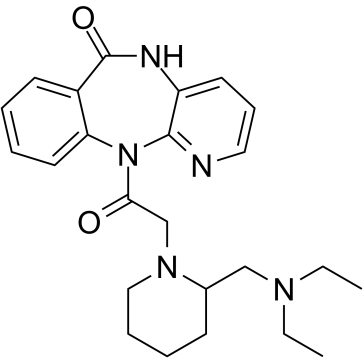CHEMICAL IDENTIFICATION
-
RTECS NUMBER :
-
UV0697000
-
CHEMICAL NAME :
-
6H-Pyrido(2,3-b)(1,4)benzodiazepin-6-one, 5,11-dihydro-11-((2-((diethylamino) methyl)-7-piperidinyl)acetyl)-
-
CAS REGISTRY NUMBER :
-
102394-31-0
-
LAST UPDATED :
-
199612
-
DATA ITEMS CITED :
-
4
-
MOLECULAR FORMULA :
-
C24-H31-N5-O2
-
MOLECULAR WEIGHT :
-
421.60
HEALTH HAZARD DATA
ACUTE TOXICITY DATA
-
TYPE OF TEST :
-
LD50 - Lethal dose, 50 percent kill
-
ROUTE OF EXPOSURE :
-
Oral
-
SPECIES OBSERVED :
-
Rodent - rat
-
DOSE/DURATION :
-
1533 mg/kg
-
TOXIC EFFECTS :
-
Details of toxic effects not reported other than lethal dose value
-
REFERENCE :
-
CDREEA Cardiovascular Drug Reviews. (Raven Press, 1185 Avenue of the Americas, New York, NY 10036) V.6- 1988- Volume(issue)/page/year: 9,30,1991
-
TYPE OF TEST :
-
LD50 - Lethal dose, 50 percent kill
-
ROUTE OF EXPOSURE :
-
Intravenous
-
SPECIES OBSERVED :
-
Rodent - rat
-
DOSE/DURATION :
-
83 mg/kg
-
TOXIC EFFECTS :
-
Details of toxic effects not reported other than lethal dose value
-
REFERENCE :
-
CDREEA Cardiovascular Drug Reviews. (Raven Press, 1185 Avenue of the Americas, New York, NY 10036) V.6- 1988- Volume(issue)/page/year: 9,30,1991
-
TYPE OF TEST :
-
LD50 - Lethal dose, 50 percent kill
-
ROUTE OF EXPOSURE :
-
Oral
-
SPECIES OBSERVED :
-
Rodent - mouse
-
DOSE/DURATION :
-
600 mg/kg
-
TOXIC EFFECTS :
-
Details of toxic effects not reported other than lethal dose value
-
REFERENCE :
-
CDREEA Cardiovascular Drug Reviews. (Raven Press, 1185 Avenue of the Americas, New York, NY 10036) V.6- 1988- Volume(issue)/page/year: 9,30,1991
-
TYPE OF TEST :
-
LD50 - Lethal dose, 50 percent kill
-
ROUTE OF EXPOSURE :
-
Intravenous
-
SPECIES OBSERVED :
-
Rodent - mouse
-
DOSE/DURATION :
-
50 mg/kg
-
TOXIC EFFECTS :
-
Details of toxic effects not reported other than lethal dose value
-
REFERENCE :
-
CDREEA Cardiovascular Drug Reviews. (Raven Press, 1185 Avenue of the Americas, New York, NY 10036) V.6- 1988- Volume(issue)/page/year: 9,30,1991
|


![5,11-Dihydro-11-chloroacetyl-6h-pyrido[2,3-b][1,4]benzodiazepine-6-one structure](https://image.chemsrc.com/caspic/041/28797-48-0.png)
![D,L-2-[(diethylamino)methyl]piperidine structure](https://image.chemsrc.com/caspic/152/100158-61-0.png)
![5,6-Dihydro-6-oxo-11H-pyrido[2,3-b][1,4]benzodiazepine structure](https://image.chemsrc.com/caspic/061/885-70-1.png)